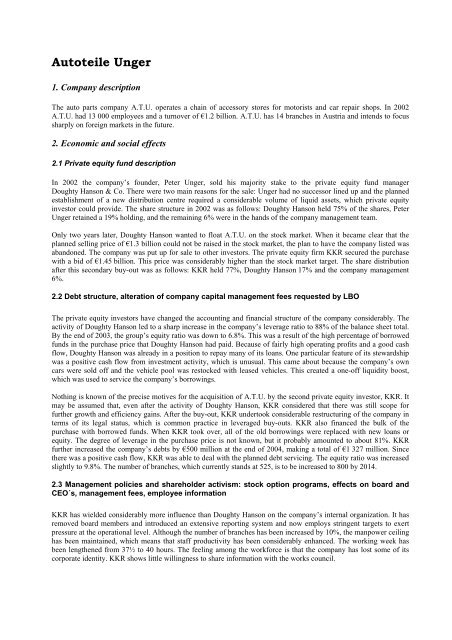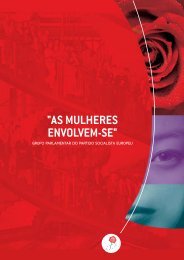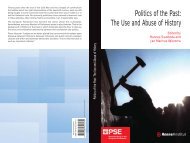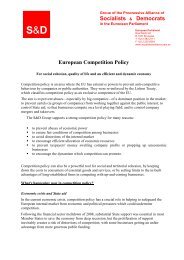Executive summary - Udo Bullmann
Executive summary - Udo Bullmann
Executive summary - Udo Bullmann
- No tags were found...
Create successful ePaper yourself
Turn your PDF publications into a flip-book with our unique Google optimized e-Paper software.
Autoteile Unger1. Company descriptionThe auto parts company A.T.U. operates a chain of accessory stores for motorists and car repair shops. In 2002A.T.U. had 13 000 employees and a turnover of €1.2 billion. A.T.U. has 14 branches in Austria and intends to focussharply on foreign markets in the future.2. Economic and social effects2.1 Private equity fund descriptionIn 2002 the company’s founder, Peter Unger, sold his majority stake to the private equity fund managerDoughty Hanson & Co. There were two main reasons for the sale: Unger had no successor lined up and the plannedestablishment of a new distribution centre required a considerable volume of liquid assets, which private equityinvestor could provide. The share structure in 2002 was as follows: Doughty Hanson held 75% of the shares, PeterUnger retained a 19% holding, and the remaining 6% were in the hands of the company management team.Only two years later, Doughty Hanson wanted to float A.T.U. on the stock market. When it became clear that theplanned selling price of €1.3 billion could not be raised in the stock market, the plan to have the company listed wasabandoned. The company was put up for sale to other investors. The private equity firm KKR secured the purchasewith a bid of €1.45 billion. This price was considerably higher than the stock market target. The share distributionafter this secondary buy-out was as follows: KKR held 77%, Doughty Hanson 17% and the company management6%.2.2 Debt structure, alteration of company capital management fees requested by LBOThe private equity investors have changed the accounting and financial structure of the company considerably. Theactivity of Doughty Hanson led to a sharp increase in the company’s leverage ratio to 88% of the balance sheet total.By the end of 2003, the group’s equity ratio was down to 6.8%. This was a result of the high percentage of borrowedfunds in the purchase price that Doughty Hanson had paid. Because of fairly high operating profits and a good cashflow, Doughty Hanson was already in a position to repay many of its loans. One particular feature of its stewardshipwas a positive cash flow from investment activity, which is unusual. This came about because the company’s owncars were sold off and the vehicle pool was restocked with leased vehicles. This created a one-off liquidity boost,which was used to service the company’s borrowings.Nothing is known of the precise motives for the acquisition of A.T.U. by the second private equity investor, KKR. Itmay be assumed that, even after the activity of Doughty Hanson, KKR considered that there was still scope forfurther growth and efficiency gains. After the buy-out, KKR undertook considerable restructuring of the company interms of its legal status, which is common practice in leveraged buy-outs. KKR also financed the bulk of thepurchase with borrowed funds. When KKR took over, all of the old borrowings were replaced with new loans orequity. The degree of leverage in the purchase price is not known, but it probably amounted to about 81%. KKRfurther increased the company’s debts by €500 million at the end of 2004, making a total of €1 327 million. Sincethere was a positive cash flow, KKR was able to deal with the planned debt servicing. The equity ratio was increasedslightly to 9.8%. The number of branches, which currently stands at 525, is to be increased to 800 by 2014.2.3 Management policies and shareholder activism: stock option programs, effects on board andCEO´s, management fees, employee informationKKR has wielded considerably more influence than Doughty Hanson on the company’s internal organization. It hasremoved board members and introduced an extensive reporting system and now employs stringent targets to exertpressure at the operational level. Although the number of branches has been increased by 10%, the manpower ceilinghas been maintained, which means that staff productivity has been considerably enhanced. The working week hasbeen lengthened from 37½ to 40 hours. The feeling among the workforce is that the company has lost some of itscorporate identity. KKR shows little willingness to share information with the works council.





